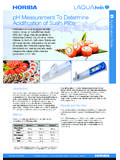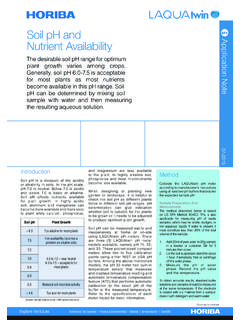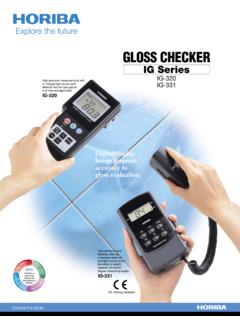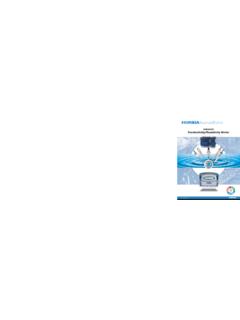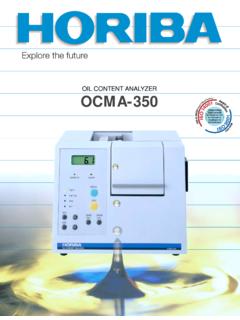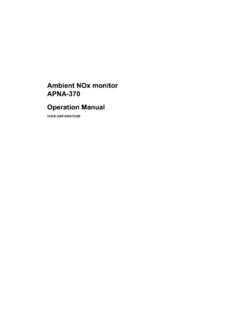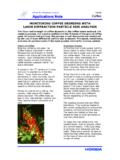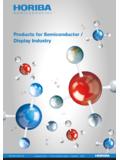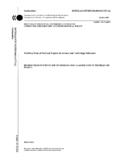Transcription of AN199 Zeta Potential of Proteins V4 - HORIBA
1 SZ-Series Particle Characterization Analyzer AN199 AAAppppppllliiicccaaatttiiiooonnnsss NNNooottteee zeta Potential of Proteins zeta Potential of Proteins zeta Potential is a key physical parameter that describes surface charge on Proteins . Although there has been interest in measuring the zeta Potential of Proteins for many years, the measurements were often difficult due to a variety of reasons including the cooking of Proteins on the cell electrodes when using light scattering techniques. This application note presents data from the SZ-100 using cells with unique, patented carbon coated electrodes that facilitate zeta Potential measurements of Proteins . Introduction The surface charge of Proteins is an important physical property that can affect their state of aggregation and how they behave during processing. The zeta Potential of a protein is an effective measurement of surface charge that can be used as an indicator of stability. Changes in zeta Potential for a protein may imply: Aggregation Conformational changes in protein structure Surface modifications Unfolding/denaturation of the protein The zeta Potential indicates the degree of repulsion between adjacent, similarly charged Proteins in a dispersion.
2 According to general colloid chemistry principles, a dispersed system typically loses stability when the magnitude of the zeta Potential decreases to less than approximately 30 mV (independent if the charge is positive or negative). As a result, there will be some region surrounding the condition of zero zeta Potential (the isoelectric point, or IEP) for which the system is not particularly stable. Within this unstable region, the Proteins may agglomerate, thereby increasing the measured size. Therefore, determining the IEP of a batch of protein sample is a common application of zeta Potential analysis. zeta Potential measurements are a preferred way to characterize the charge on the surface of Proteins , although practical considerations with the analysis have hindered wide spread adoption of this technique. Classic gold plated electrodes used in disposable zeta Potential cells created Joule heating resulting in the blackening of the electrode surface, rendering the cell useless, often after a single measurement.
3 This heating not only damages the sample and cell, but also degrades data quality since the induced electric field is changed by the protein cooking onto the electrodes, as shown in Figure 1. Figure 1: Blackened gold coated electrode surface indicating a ruined cell HORIBA has pioneered the use of carbon coated electrodes see Figure 2 - used in disposable zeta Potential cells in order to address measurement challenges of difficult samples like Proteins . The experiments described in this application note were all performed using disposable zeta Potential cells with carbon coated electrodes. SZ-Series Particle Characterization Analyzer AN199 AAAppppppllliiicccaaatttiiiooonnnsss NNNooottteee zeta Potential of Proteins Figure 2: A carbon coated electrode zeta Potential cell, usable after several hundred measurements Experimental The Proteins used for this study included bovine serum albumin (BSA) and lysozyme. Lyophilized BSA powder purchased from Fisher Scientific (CAS: 9048-46-8) and lyophilized lysozyme powder purchased from Sigma Aldrich (L6876) were prepared by dissolving in ultra pure DI water at a concentration of 100 mg/mL.
4 The concentration was intentionally much higher than the sensitivity limit of the instrument since the pH titration dilutes the sample during the course of the experiment. The pH titrations were performed manually rather than using the LY-701 automated titrator due to the small sample volumes associated with protein work. The chemicals used for the pH titrations were HCl and NaOH. pH measurements were made using a HORIBA TwinpH compact pH meter. zeta Potential and particle size analysis measurements were made using the HORIBA SZ-100Z nanoparticle analyzer, see Figure 3. Figure 3: The SZ-100 Nanoparticle Analyzer Particle size measurements were performed prior to the pH titrations using a glass cell at 90 . zeta Potential measurements were all made using the same disposable cell with carbon coated electrodes. This same cell had already been used for over 800 zeta Potential measurements on an emulsion sample see TN167 Lifetime of zeta Potential Cells. For Lysozyme the pH was lowered to 4, then increased at increments of 1 pH unit up to pH 13.
5 For BSA the pH was lowered to 3, then raised up to pH Three zeta Potential measurements were made at each pH point and the average value was recorded and displayed in the results shown in Figures 4 and 5. Results The particle size of the lysozyme sample was determined to be nm prior to beginning the pH titration. The zeta Potential results vs. pH values are shown in Figure 4. The IEP value of is similar to other published results. SZ-Series Particle Characterization Analyzer AN199 AAAppppppllliiicccaaatttiiiooonnnsss NNNooottteee zeta Potential of Proteins -10-50510152002468101214pHzeta Potential Figure 4: IEP of Lysozyme protein The particle size of the BSA samples was determined to be nm prior to beginning the pH titration. The zeta Potential results vs. pH values are shown in Figure 5. The IEP value of is similar to other published results. -50-40-30-20-10010203040012345678910pHZe ta Potential Figure 5: IEP of BSA protein Conclusions The zeta Potential of the lysozyme and BSA samples varied as a function of pH as expected.
6 The iso-electric point (IEP) titrations were easily and automatically performed in about one hour each. The disposable zeta Potential cell with carbon coated electrodes used for the measurements showed no signs of degradation and was later used for many more measurements without failure. The innovative use of carbon coated electrodes appears to have transformed the zeta Potential analysis of Proteins into a simple experimental technique that can be performed by any user. A word of caution that salt concentration or other sample properties may reduce the lifetime of the zeta Potential cell to below the values reported in this application note. That said, many applications are made easier and the cell lifetime extended with this unique carbon design. Copyright 2011, HORIBA Instruments, Inc. For further information on this document or our products, please contact: HORIBA Jobin Yvon 16-18, rue du Canal - 91165 Longjumeau, France Tel. +33 (0)1 64 54 13 00 HORIBA Ltd.
7 2, Miyanohigashi, Kisshoin Minami-Ku Kyoto 601-8510 Japan +81 75 313 8121 HORIBA Scientific 34 Bunsen Irvine, CA 92618 USA 1-888-903-5001
